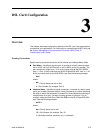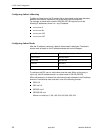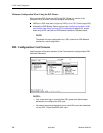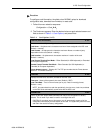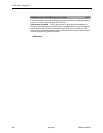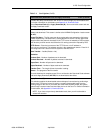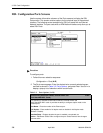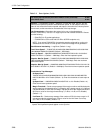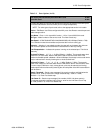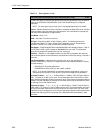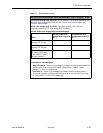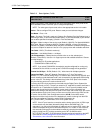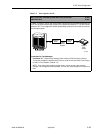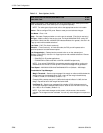
3. DSL Card Configuration
8000-A2-GB26-50 April 2001
3-9
Ethernet Port (8343 SDSL and 8303 IDSL Cards) A-B-A
This selection is available for 8343 SDSL and 8303 IDSL cards. It provides the ability to
configure speed and duplex mode on the Ethernet port.
Port Name
– Enter the number of the Ethernet port.
Auto Negotiate
– Enable to allow the port to automatically select the best rate and duplex
mode between this port and the Ethernet device(s). If disabled, you can manually
configure the port using the following fields (Default = disable).
Speed
– Enter 10bT (10BaseT) or 100bT (100BaseT). (This field is read-only and
displays the negotiated speed if Auto-Negotiate is set to Enable.)
Full Duplex
– Enter enable for Full-Duplex mode or disable for Half Duplex mode
(Default = Disable). Full Duplex is not supported if speed is set to 100bT.
Interface State
– Displays whether the port is enabled, not selected, etc.
Action
– Edit/Reset. Select Edit to configure the port. Select Reset to have changes
become active.
DSL Ports (DSL Parameters) 8510/8373 RADSL Cards A-B-B
8374 RADSL Card A-B-A
Allows configuration of the operational and alarm parameters of the RADSL ports on the
8510/8373/8374 RADSL cards. Each RADSL port is configured separately.
NOTE: For other types of port cards, refer to the appropriate section in this table.
Action
– Edit to configure DSL ports. Reset to reset port and activate changes. Save to
save changes (allows you to edit, then save multiple ports without having to exit the
screen).
Save Changes?
– Enter yes or no. If you enter yes, you can edit another port before
exiting the screen via a reset.
Port Name
– Enter 1–4 for 8510 or 1–12 for 8373/8374.
State
– Port state. This field is read-only. For 8510, displays whether or not the port is
selected. For 8373/8374, displays Port Enabled, Port NOT Enabled (port is performing a
reset, or has never been made active), or Port NOT Selected (a port number has not
been specified for display).
SN Type
– Model number of the service node. For Model 8510/8373/8374 RADSL Cards,
SN type is 5620, 6371, 6371R2, 6372, and 6372R2 (R2 indicates Release 2 or greater)
(Default = 5620). Use Ctrl-v for a pop-up menu with available selections.
SN Tx Power
– 0 dB, –3 dB, –6 dB, –9 dB. Enter the Service Node transmit power: 0, –3,
–6, or –9 dB (Default = –6 dB).
Tx Power
– 0 dB, –3 dB, –6 dB. Enter the rate that allows you to reduce the transmit
power by: –3 dB or –6 dB (Default = 0 dB). Short loops require less power, reducing
crosstalk and giving better performance on longer loops in the same cable bundle.
Startup Margin
– SM determines the quality of the connection of the upstream link on
system startup. It is used in conjunction with the adaptive speed fields to determine the
initial line speeds of the DSL link. The value is between –3 and 9. In Adaptive Mode, if the
margin falls below SM, the DSL link will be restarted at a slower speed. If the calculated
margin of the next speed is greater than SM by 3 dB, the speed will increase.
Enter –3 to 9 (Default = 3).
Table 3-2. Ports Options (2 of 9)



